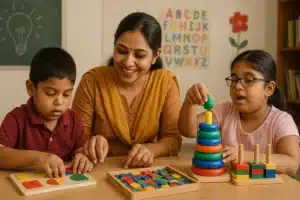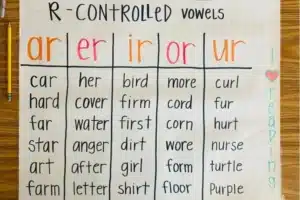
Source : goodtherapy
Learning Disorders are conditions in which due to a certain neurological malfunctioning the brain processes at a much slower pace. In the current educational landscape Dyslexia and Dysgraphia are commonly known learning disorders that hamper language skills. To help children with these learning disorders it becomes mandatory to know what is the difference between Dyslexia and Dysgraphia symptoms become extremely essential While both affect learning skills, they manifest in unique ways. In Dyslexia children find it difficult to sound out words due to poor identification of letters. Dysgraphia is concerned primarily with letter formation and word spacing. hampers a child’s writing skills.
Understanding what are the exact dyslexia and dysgraphia symptoms benefits trainees in chalking out the apt lesson plans and tools that help make a difference in the learning patterns of children who face dysgraphia and dyslexia. This examination of dyslexia and dysgraphia symptoms aims to highlight their changes in what they are, the signs to look out for, areas impacted, and how accommodations can make a noteworthy difference.
Can a Child have Dyslexia and Dysgraphia Symptoms together?
Dyslexia and Dysgraphia are two distinct conditions with distinct neurological and behavioral profiles but they can co-exist simultaneously. Here is a closer look at how these conditions can coexist, the common signs observed, and the impact on the kid:
Occurrence of Dyslexia and Dysgraphia together
Dyslexia is a result of the brain’s slower processing of language skills and poor phonemic awareness due to which they find it difficult to segment words into their corresponding sounds.
- Dysgraphia affects writing skills, leading to difficulties in handwriting, organizing opinions on paper, and spelling correctness.
Common Signs Observed
- Struggle with reading aloud, identifying words, and comprehending written text.
- Difficulty holding a pencil correctly, writing illegibly, and maintaining proper spacing between words and alphabets.
- Challenges with spelling, including simple words they can orally spell out.
- Avoidance of reading and writing tasks, which may appear as disinterest or frustration.
Impact on the Child
- Academic performance may not reflect the child’s true intelligence or verbal skills.
- Lower self-esteem and increased anxiety, especially related to schoolwork and tests.
- Challenges in following multi-step instructions and organizing thoughts for written assignments.
Identifying dyslexia and dysgraphia symptoms initially can lead to targeted interventions that meaningfully improve a kid’s learning experience. Structured strategies, such as using technology aids, executing teaching adjustments, and providing emotional support, can empower kids with dyslexia and dysgraphia symptoms to thrive educationally and individually. Identifying and addressing dyslexia and dysgraphia symptoms not only helps in overwhelming educational challenges but also in advancing the kid’s confidence and enthusiasm for education.
For more details on Learning Disability Courses, Call / Whatsapp on +919321024137 / +919869866277.
To download the brochure of Learning Disability Courses, Click Here!

Source : kashmirconvener
Are there Teacher Training for Dyslexia and Dysgraphia Courses Available?
Teacher training for dyslexia and dysgraphia courses is not only necessary but also transformative in the learning sector as undergoing them enables trainees to formulate strategies that make a significant difference to a child’s academic performance.
Vidhyanidhi Education Society’s endeavor to bridge the gap between the need for trained professionals and the demand has helped curate a job-certifying educational Learning Disability program with some outstanding attributes.
Specialized Curriculum
VES offers courses precisely designed for teacher training for dyslexia & dysgraphia. These courses are structured to prepare teachers with the information and tools to recognize and support dyslexia and dysgraphia symptoms in learners.
Hands-On Training
The teacher training for dyslexia & dysgraphia contains practical approaches and interventions that educators can implement in their schoolrooms. This practical approach ensures that teachers can effectively provide the unique needs of learners with dyslexia and dysgraphia symptoms.
Comprehensive Support
VES provides ongoing support and resources to teachers undergoing the training. This support system is crucial for the successful integration of learned strategies in real-world educational settings.
Focus on Learning Differences
The courses highlight the importance of understanding the diverse learning differences among students. Identifying the specific dyslexia and dysgraphia symptoms permits educators to adjust teaching methods accordingly.
Empowering Educators
By completing the teacher training for dyslexia & dysgraphia at VES, teachers are authorized to create a comprehensive and supportive learning atmosphere. This not only benefits learners with learning disabilities but improves the complete educational experience for all learners.
Vidhyanidhi Education Society’s (Govt. regd.) dedication to offering specialized teacher training for dyslexia & dysgraphia covers the way for a more comprehensive and effective educational setting. Teachers prepared with accurate information and tools to manage dyslexia and dysgraphia symptoms are crucial for nurturing a helpful learning atmosphere for every learner.
Unlock learning success with Vidhyanidhi’s course on dyslexia & dysgraphia!
For more details on Learning Disability Courses, Call / Whatsapp at +919321024137 / +919869866277.
To download the brochure of Learning Disability Courses, Click Here!
Dyslexia and Dysgraphia Symptoms
FAQs
Can you have Dyslexia and Dysgraphia?
Yes one can have Dyslexia and dysgraphia which can be hidden disabilities that impact the reading and writing abilities of children. They impact about 10% of the World's population.
What Percentage of Dyslexics have Dysgraphia?
Approximations differ, but about 20-40% of people with dyslexia also experienced dysgraphia, highlighting the overlay between these education difficulties.
Can you be Dyslexic but Good at Writing?
Absolutely, many dyslexics excel at writing. They may use creative strategies and assistive technology to effectively navigate challenges and express their ideas.



